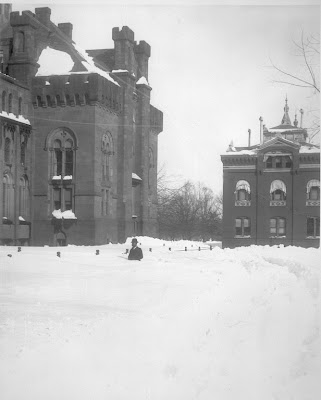 Nothing epitomizes summer more than ice cream. I'm a Rocky Road in a waffle cone kind of girl with fond, fond memories of summers saving my parents' spare change for the day when the ice cream truck would come trundling down our neighborhood block. The obnoxious childhood nursery songs being sweet music to my brother and I's ears as it promised the thrill of the chase, finished with sweet satisfaction as the ice cream dribbled down our chins and onto the hot, steamy sidewalk.
Nothing epitomizes summer more than ice cream. I'm a Rocky Road in a waffle cone kind of girl with fond, fond memories of summers saving my parents' spare change for the day when the ice cream truck would come trundling down our neighborhood block. The obnoxious childhood nursery songs being sweet music to my brother and I's ears as it promised the thrill of the chase, finished with sweet satisfaction as the ice cream dribbled down our chins and onto the hot, steamy sidewalk. Even as I grew older, summer ice cream still held a soft spot in my heart. On hot summer nights I would put on my favorite red Hawaiian flower summer dress to match my high school sweetheart's cherry red Jeep, and we'd head out for a scoop at our local ice cream spot. Ice cream is to summer as hot chocolate is to winter, and any of you who are a sweets person will understand the nostalgia that can be deliciously wrapped around those childhood treats.
This image, for me, evokes the feelings of summer. It inspires a thoughtful and touching retrospective on life to see a food icon like ice cream transcend historical, cultural and geographical constructs. To see these people gathered around their version of an ice cream truck resonates with my own childhood memories and fondness for ice cream. When an image has the power to resonate and connect with you on such an internal level, it further unfolds by allowing you to feel a genuine and sincere connection to the subjects involved. Beyond time, space, and geolocation, I feel connected to this image and these people - and that is a rare and beautiful thing in this life.
So here I am, walking down memory lane and dishing up ice cream for you - old school. This image is taken by the famous Antoin Sevruguin (1830s-1933), who was an official photographer of the Imperial Court of Iran. His commercial photography studio was one of the most successful in Tehran from the late 1870s to about 1934. The images in this collection provide a rich visual documentation of the Qajar and early Pahlavi dynasties of Iran.
The astonishing range of Antoin Sevruguin's photographs, and the prolific output of the studio, provides today's viewer with an important resource for examining the cultural histories and hierarchical elements of Iranian society. They assist the scholar in studying architectural sites that may have been damaged or destroyed, or are unavailable for first-hand investigation. Increasingly, the prints are valued for their artistic elements that may sometimes overshadow their documentary value. Most significantly, Sevruguin's images form part of an ongoing history that links a distant past and place to the present.
Caption: The Ice Cream Vendor, Antoin Sevruguin. Circa 1890. Caption on Photograph: La Glace. Note: Staged in Drill Square in Tehran. Gelatin silver print. Freer Gallery of Art and Arthur M. Sackler Gallery Archives, Smithsonian Institution, Antoin Sevruguin collection, part of the Myron Bement Smith collection.
Rachael Cristine Woody
Archivist
Freer Gallery of Art and Arthur M. Sackler Gallery Archives
woodyr@si.edu












![The Diana Davies Photograph Collection, 1963- [Series XI: Social Justice: Peace Movement, Civil Rights Movement, Poor People's March, ...] The Diana Davies Photograph Collection, 1963- [Series XI: Social Justice: Peace Movement, Civil Rights Movement, Poor People's March, ...]](https://blogger.googleusercontent.com/img/b/R29vZ2xl/AVvXsEhukRoJcjN60PV5k6xMY449y2uosJ8H1OhX_NnYnY0iaTTjqkd80DtPS6-klmP1e3YpGennzm45mdQ4qFaGDi6HgMGI2sf38ZSQNiRRruYNu6HA78stHTyK50y8m2eAJbpQFjRW_0aT05Q/s320/deliveryService.jpg)


![[Garden scene with dancers, to be used as the set for a miniature theater] [graphic]. Engelbrecht, Martin, 1684-1756. Cooper-Hewitt, Smithsonian Institution. [Garden scene with dancers, to be used as the set for a miniature theater] [graphic]. Engelbrecht, Martin, 1684-1756. Cooper-Hewitt, Smithsonian Institution.](https://blogger.googleusercontent.com/img/b/R29vZ2xl/AVvXsEiPaalD5p-YleKQ0C9pGVriw_dHrUOSV8XW1V4wrPeKM-QM2zjYa6zB8EMMxr3iSU7gqU5aFsIFnsouiQAAivwfMGWBWO3qoSru1makmvSK5n-QcdCnex-XqyLvm7eSYiasQZaCiYEKonA/s400/4554834794_915b15c7c3.jpg)
















